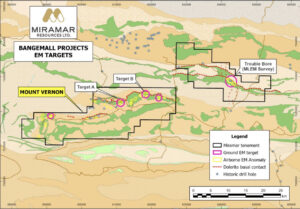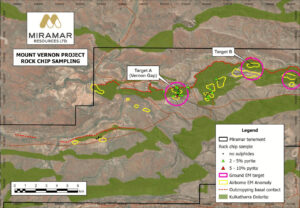- Miramar Resources encouraged by initial results of EM survey over its Mount Vernon project in WA’s Gascoyne region
- Mount Vernon is part of the Bangemall tenements which could host Norilsk-style nickel-copper-PGE mineralisation never before seen in WA
- Drilling yet to be conducted within the vicinity of two key targets identified from ongoing survey work
Special Report: Miramar Resources has made a promising start in its quest to prove up a style of nickel-copper-PGE mineralisation not previously observed elsewhere in Western Australia.
Miramar Resources (ASX:M2R) today reported an electromagnetic (EM) survey currently underway over its Mount Vernon project in WA’s Gascoyne region has identified multiple, strong conductors which indicate the potential for nickel-copper sulphide mineralisation.
Mount Vernon is part of the company’s Bangemall tenements which M2R executive chairman and renowned exploration geologist Allan Kelly previously suggested hosts the potential for Norilsk-style nickel, copper and platinum group element (PGE) mineralisation related to the Kulkatharra Dolerite sills.
These sills are part of the Warakurna Large Igneous Province and the same age as the massive Nebo-Babel deposits being developed by BHP (ASX:BHP) in the West Musgraves region.
M2R’s exploration strategy for the project is borne out of the belief the Bangemall tenements have the potential for a style of mineralisation typically seen among the giant Norilsk nickel-copper deposits in Siberia, and could be the first of its kind to be discovered in WA.
The initial survey results are in…
A fixed-loop EM (FLTEM) survey is currently underway over the Mount Vernon and Trouble Bore areas with the aim of refining EM anomalies previously outlined by previous airborne surveys.
This FLTEM survey has identified multiple late-time conductors at the first two targets tested to date, with modelling of the data suggesting south-dipping conductive plates near the base of the dolerite sill where nickel-sulphides are thought to have accumulated.

Target A showed three large south-dipping plates with moderate conductances of ~600 Siemens, while Target B showed five large south-dipping plates with conductances ranging from 250 to 1,200 Siemens.
All plates are interpreted to be within 70m of surface – therefore within reach of the RC drill bit.
No previous drilling has ever been completed in the vicinity of either target.
M2R also noted other evidence that the dolerite sill being targeted at Mount Vernon has undergone differentiation and could therefore host nickel-copper-PGE sulphide mineralisation. This reasoning was based on variation in grain size from very fine-grained chill margins at the extremities to coarse-grained gabbro in the centre of the sill.
Other encouraging evidence includes an increasing magnesium oxide (MgO) content towards the bottom of the sill, and nickel-chromium-titanium ratios which suggest the presence of mafic cumulate rocks.
Is Kelly on the cusp of another game-changing discovery?
Kelly, who led the discovery of the high-grade Andy Well gold mine for Doray Minerals, is delighted with the progress M2R is making in the Gascoyne region.
“We are the first company to explore for this style of deposit in the Bangemall region,” he said.
“At Mount Vernon, we identified multiple anomalies from our airborne EM survey and now the first targeted ground EM surveys have confirmed and refined those large anomalies, any one of which could represent an accumulation of nickel-copper sulphide mineralisation.
“This is the tip of the iceberg for the Bangemall region, with the next step involving the first targeted drilling of the best airborne and/or ground EM anomalies.
“We are very excited about the project, as if we can show proof of concept of the Norilsk-style deposit model at Mount Vernon and/or Trouble Bore, it opens up the entire Bangemall region as a new nickel-copper province, one where we have built a dominant landholding.”
Meanwhile, back on the ground…
During the December quarter, M2R field crews collected a total of 51 rock chip samples from various locations across Mount Vernon.

All but one sample was of material taken from outcropping dolerite sills.
Samples were initially analysed in the field by handheld portable XRF and then subsequently submitted for a multi-element suite. Whilst several showed anomalous nickel above 150ppm, many others with MgO results >8% indicate the presence of mafic cumulate rocks within the dolerite sills.
This is the first time that samples with this level of MgO have been seen in the area.
Upcoming work at Bangemall post completion of the ground EM surveys includes RC drill testing and progressing existing tenement applications to grant, including identifying other prospective areas to peg and/or acquire.
M2R is also seeking to apply for funding under the WA Government’s Exploration Incentive Scheme (EIS).
This article was developed in collaboration with Miramar Resources, a Stockhead advertiser at the time of publishing.
This article does not constitute financial product advice. You should consider obtaining independent advice before making any financial decisions.
The post Miramar Resources is the first company to explore for this type of deposit in WA appeared first on Stockhead.


